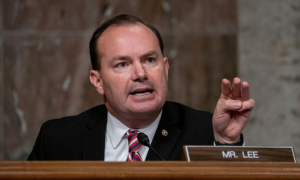While attending the annual international security conference in Munich earlier this year, I heard Trump administration officials tell a skeptical audience that the United States was still leading the world. A European official turned to me and said: “They should substitute ‘v’ for ‘d,’ because it feels more often like this administration is leaving the world.”
It’s not hard to understand where this comment came from. Trump, after all, has a record of pulling out of institutions and agreements and leaving nothing but a gaping hole — a vacuum that has led to a continuing global decline of confidence in U.S. leadership.
Here are five case studies of Trump withdrawals and what happened next.
1. The Trans-Pacific Partnership (TPP). Three days after taking office in 2017, Trump pulled out of the deal, which the United States and 11 other countries had negotiated over several years and signed in late 2016. It comprised 40 percent of the global gross domestic product and covered everything from labor laws to environmental regulations. While not perfect — compromises never are — trade analysts generally agree that it would have boosted American exports and growth, particularly for agriculture, machinery, autos and plastics.
What Happened Next? The 11 other signatories formed their own pact without Washington, calling it the Comprehensive and Progressive Agreement for Trans-Pacific Partnership. They axed two dozen provisions that the U.S. had fought for and that they had opposed. Meanwhile, China, not part of that agreement, threw its weight behind a comparable pact, the 15-nation Regional Comprehensive Economic Partnership, whose Asia-Pacific members comprise one-third of the Earth’s population and production. Trump stood apart, giving up on being a part of something generating a combined 50 percent of global GDP, forfeiting leverage over China, sparking a trade war with Beijing and compensating farmers for production they would not have lost under TPP.
2. The Paris Climate Accord. Last November, Trump initiated the procedure to formally withdraw from the accord, as he had pledged to do in 2017. The agreement has been ratified by 189 of the 197 signatories; the U.S. is the only country leaving. Trump accuses climate scientists of pushing a “political agenda.”
What Happened Next? With the U.S. gone, China — despite backsliding on its climate commitments — has gained prominence in the grouping as climate scientists continue to say the world must cut carbon emissions in half by 2030 to avoid irreversible effects on the environment. China is poised to benefit if green energy takes off, because it has become the world’s largest producer of solar and wind energy and the biggest investor in green energy projects. Trump shows no interest in wind, solar or other renewables, continuing instead to preach the virtues of coal.ADVERTISING
3. The Iran Nuclear Agreement. In 2018, Trump pulled out of this agreement, negotiated in 2015 by the U.S., the United Kingdom, Germany, France, Iran, Russia and China. Iran agreed to give up 98 percent of its enriched uranium and 14,000 of its 20,000 centrifuge enrichment machines, plug its heavy water reactor for producing plutonium and enrich no uranium above 3.67 percent before 2030 (enrichment of approximately 90 percent is needed for a weapon). The International Atomic Energy Agency said Iran was in compliance, but Trump complained that the agreement did not cover Iran’s terrorist activities and allowed some of its nuclear work to resume in 10 to 25 years. He demanded a tougher agreement.
What Happened Next? Trump has not gotten a tougher agreement — despite a “maximum pressure” campaign of sanctions and other measures. Instead Iran has more than tripled its stockpile of enriched uranium, breached its limits on heavy water for plutonium, and is now less than a year from a bomb. Meanwhile, our three major European allies oppose Trump’s approach and agree with Russia and China in wanting to keep the accord alive.
4. The Intermediate-Range Nuclear Forces Treaty. Trump withdrew last August from this 1987 treaty with Russia. To be fair, one of Russia’s new missiles put it in violation and Moscow rebuffed that charge. However, this leaves the 2011 New Start Treaty (reducing intercontinental-range missiles) as the sole remaining nuclear weapons reduction agreement with Russia. It is set to expire in seven months. The Trump administration rejects the simplest path, which is to buy negotiating time by renewing for five years with a simple signature.
What Happened Next? Moscow and China seized the propaganda high ground, charging the U.S. with recklessness. Our European allies acknowledged Russia’s violations but also worried that with no theater-range treaty the international arms control regime is weakened and European security is jeopardized. For both this treaty and New Start, Trump wants to bring in China, but Beijing, which has a much smaller arsenal, flatly refuses — and nothing in Trump’s record suggests an ability to manage such a complex negotiation. Failure to revive a version of New Start would undermine the international nuclear nonproliferation regime, in which countries’ non-nuclear pledges are contingent on U.S.-Russia commitments to continue bilateral reductions.
5. The World Health Organization (WHO). Last month Trump announced his intention to end 72 years of U.S. membership in WHO, citing his claim that the organization favored China.
What Happened Next? The Republican chairman of the Senate Health Committee said withdrawal could interfere with clinical trials for a coronavirus vaccine and with U.S. ability to stop future viruses before reaching the United States. China crowed about its fidelity to WHO and pledged $2 billion (it’s unclear, though, how much of this is propaganda). The American Medical Association “strongly urged” Trump to reconsider, as did a number of international members, including the European Union.
These cases show the fundamental flaw with Trump’s America First foreign policy. Its sin is not its leaving agreements, many of which are imperfect and in need of improvement. Its sin is doing so with no idea, plan or process to replace them but only a vague vision that fades in the face of the hard, painstaking work to get something done.
The net result is a sharply diminished U.S. ability to affect events and a near-universal loss of confidence in U.S. global leadership.




